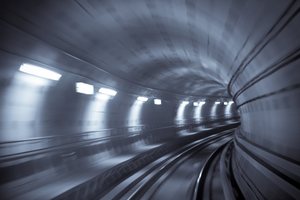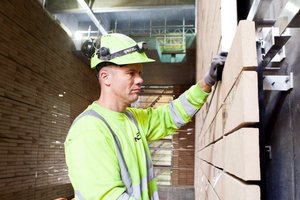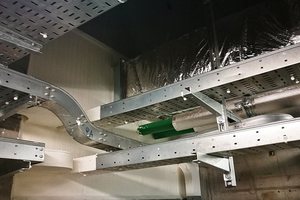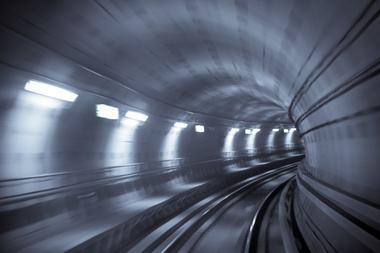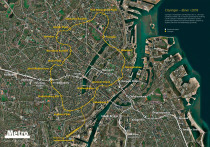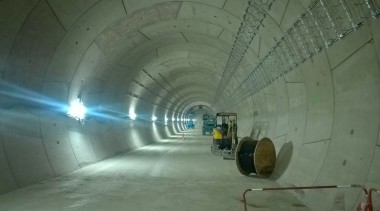Fixing Solutions for Copenhagen’s Cityringen Metro
Reducing the time it takes to get between destinations within the metropolitan region while increasing the rail transport capacity – the Danish capital Copenhagen is currently expanding its metro system with these objectives in mind. The Cityringen is a central component alongside metro lines to Nordhavn and Sydhavn. Modern fixing solutions are securing the railway equipment, fire protection systems, signalling technology, media conduits, the wall covering and much more.
The Cityringen Project
The expansion of the Copenhagen metro network constitutes an important contribution to the improvement of infrastructure and development in the metropolitan area. According to the owner and operator Metroselskabet I/S, almost 65 million passengers are already using the network every year while the influx of new inhabitants to the Danish capital continues to grow.
Construction of the Cityingen began in 2011 and it is set to be opened until the end of 2019. The underground express train system will connect the Danish Parliament, the City Hall, important national monuments and other central areas of the city. The circle line will also see Copenhagen’s central station being connected to the city’s metro network for the first time. In total, the Cityringen will serve 17 new metro station on line M3. Upon completion, the driverless metro trains will transport up to 240 000 passengers around the clock every day at an average speed of 40 km.
The total cost of the project Cityringen amounts to approximately 3.2 billion euro. The owner Metroselskabet I/S awarded the construction contract to the Copenhagen Metro Team, a joint venture between the three Italian firms Tecnimont Civil Construction, Salini S.p.a. and Seli. Salini and Impregilo merged into one group in 2014 that now owns 99.9% of the shares of the Copenhagen Metro Team. Excavation works for the twin-tube tunnel system have already been completed. Two tunnels with a diameter of 5.78 m and a length of 15.5 km each were bored through the Copenhagen limestone at a depth of 25 m through EPB-TBM excavation.
Fixing and Installation Systems
With over 300 subcontractors the Cityringen is one of Europe’s largest metro construction projects. The German Fischer group of companies is also involved in the project, supplying numerous temporary and permanent fixing and installation systems while providing support during their on-site installation. The tunnel construction consists of concrete and reinforced concrete as well as prefabricated segments as the load-bearing structure. The Fischer fixing and installation systems utilised provide safety through the assessments required in tunnel construction. The products have been tested in accordance with European and international standards and for the most part have an ETA (European Technical Approval) as well as a UL and ICC approval for the USA and countries in the Far East. The fixing and installation systems are made out of high-grade materials such as stainless and non-corrosive steel and are resistant against fire, seismic influences as well as dynamic and impact loads.
Marco Cannone, project manager for international construction projects at Fischer Italy, is heavily involved in the project. “We convinced the contracting authority of the project Cityringen with suitable solutions and special technical developments for all fixing tasks to build the tunnel. Our services also included measurements and calculations of suitable fixing, installation and facade systems,” he says.
Temporary channels, cables and pipes for ventilation, lighting and the supply and disposal of water in the Cityringen were installed using the Fischer nail anchor FNA II and the FBS Fischer concrete screw, in accordance with the corresponding load requirements. The easy to install, self-drilling concrete screw FBS enables complete disassembly, making it ideal for temporary anchorings. The latest version also combines the advantages of an easy-to-install nail head design with the possibility of disassembly. The nail head simply needs to be cut off before the disc is removed and the remainder of the nail is subsequently cut off close to the surface of the concrete. The FNA II is also used for to secure the drainage line against buoyancy with the pre-drilled metal holders at the invert, to avoid any movement of the drainage during the filling of the section with cement.
The FNA II can be also used in combination with washers und spacers in order to attach reinforcement nets for the die cast fire protection plaster and the installation of fire protection plates. Operators therefore save time and effort during installation due to the standard anchorage depth of just 30 mm (with a drill hole depth of 35 mm). The nail anchor is suitable for fixture thicknesses of up to 120 mm. All products are also available in non-standard dimensions on request.
The stainless-steel version of the FBN II was used to make the waterproofing membrane of the tunnel segments at the area of the wall bushings of the stations watertight. The Fischer bolt anchor FAZ II and FBN II as well as the nail anchor FNA II were used for all the structural installation in the Cityringen. Empty cable conduits or heavy cable runs can be safely and permanently anchored with the fixings, therefore covering all load requirements. A rail fastening system is used to fix rails to railway sleeper, which, among other things, usually consists of rail anchors, rail tie plates, chairs, spikes, screws and track bolts. The selection of a fastening system for rails must be made with utmost care safety can’t be compromised. The Fischer injection mortar FIS EM was used in combination with the threaded rod FIS A in order to attach the conductor rail (3rd rail), safely transferring the high loads into the fixing substrate even if the drill hole is shallow.
Undercut anchors and substructures from the ACT system were used in order to mount the facade cladding in the stations with natural stone and hand-made bricks. The system is suitable for claddings made out of any type of material. The undercut technology systems transfer the loads in a form-fit and completely expansion-free manner. Corrosion-resistant and fire proofed installation systems attach the pipes and cables for supply and disposal of the tunnel with electricity and water as well as ventilation. The entire Fischer Firestop System was also implemented for passive fire protection.

